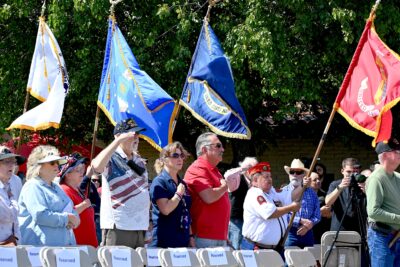We hear the phrase: “It’s a small world” more often than ever in our Internet age. Here in the Santa Clarita Valley the truth of that phrase is proven time and time again for me. These last several weeks, my “Veteran Corner” included Vietnam veterans I have served with and who live nearby.
This week I spoke with Jim Hogan, who serves on our Santa Clarita Valley Veterans Memorial Inc. Our committee coordinates SCV’s annual Memorial Day ceremonies.
Coincidentally, Jim served with the Brown Water Navy in the Mekong Delta along with my old 9th Infantry Division during the Vietnam War, though Jim arrived after my tour of duty ended.
Jim was born in Beloit, Wisconsin, in September 1947; his family moved to the San Fernando Valley in 1957, where he grew up and graduated from Birmingham High School in 1966.
During Jim’s youth he dealt with moderate hearing loss and he attended special education classes to help him function in the hearing world.
During and after high school, Jim worked for his stepfather as a liquor store clerk and assistant manager, later becoming a short-order cook.
But in the summer of 1967 he received his greeting letter from Uncle Sam. Jim was drafted into the U.S. Army.
However, at Los Angeles’ induction station he was deemed 4F due to hearing loss. This did not sit well with Jim as he had a strong sense of patriotism. After all, his father and four uncles served in World War II.
Jim felt that he should serve his country, especially since so many young San Fernando Valley men were called up or were volunteering for military service.
For Jim, and a great many Americans, President John F. Kennedy’s words were compelling: “Ask not what your country can do for you; ask what you can do for your country.”
In 1969, while living in Santa Clarita and working in Reseda, Jim met a Navy recruiter. The two became fast friends and, for a short time, apartment roommates.
It was his recruiter friend who encouraged Jim to join the Navy. Of course the hearing test took two tries, but Jim figured out how to pass. He entered boot camp May 1969 in San Diego.
Within two weeks of boot camp graduation, Jim’s commander suspected Jim’s hearing loss and ordered a complete evaluation. Jim took five hearing tests in succession and failed them one after the next.
He was told that he was unfit for military service and would be medically discharged, which Jim found completely unacceptable. He told the captain that he wanted to perform his military service in the commissary or as a cook.
However, Jim was ordered to his barracks for further orders. There he borrowed money to make a long-distance phone call to his Navy recruiter friend and explained his dilemma.
His friend simply said that he would look into it. Strangely, nothing further was ever mentioned and Jim completed his training and graduated from boot camp.
After training, Jim was ordered to the USS Whitfield, a supply and barracks ship that was docked in Yokosuka, Japan. Nervously, Jim experienced his very first airplane ride, as we all did back then.
Soon Jim’s ship transported supplies, Marines and Army troopers to Vietnam from Okinawa, the Philippines, etc.
Elements of the U.S. Navy and U.S. Army had formed in 1967 to create the Mobile Riverine Force, known as one of the most unique fighting forces in our military history.
Navy barracks ships and upgraded WWII craft provided a base of operations and means of travel for 9th Division troopers into the Mekong Delta’s countless waterways.
The Mekong was extremely dangerous and MRF’s mission was to destroy the Viet Cong. Jim’s ship, the USS Whitfield, rejoined this flotilla in 1969 after its renovations were completed at Yokosuka, and that’s when Jim first served in Vietnam.
Ultimately, he served three tours of duty in Vietnam primarily with Whitfield’s Deck Division, known as the ship’s workhorse — all activities were coordinated there.
Jim also manned the gunnery division’s 3.5-inch guns and provided night time guard duty on deck scouring the shore line with night vision scopes. That’s when he first noticed his vision was deteriorating.
In March 1972, Jim was reassigned to the USS Enterprise in Alameda and soon headed to participate in President Nixon’s final push bombarding North Vietnam into ending the Vietnam War.
In December 1972, the North Vietnamese returned to the peace table and in January 1973, a cease-fire agreement was announced, thus ending the Vietnam War.
Jim received an honorable discharge on July 5, 1973, and returned home through San Francisco’s airport and — like so many of us — he endured harassment from anti-war crowds who assembled there.
Undeterred, he returned home, making a career as a building inspector for Los Angeles. Jim married Pam Eldridge Jan. 7, 1975, and they have two daughters.
Jim was declared legally blind in October 1999 and was assigned desk work with L.A. City until retiring May 2006. Since then, he has been very active supporting veterans.
He’s received numerous awards such as Recipient of The Department of Veterans Affairs Voluntary Service, National Advisory Committee 2014 Male Volunteer of the Year, and received the Blinded Veteran’s Association Major General Melvin J. Maas Achievement Award for 2015.
Jim was one of the early committee members who worked to fund and create Newhall’s Veterans Historical Plaza. He remains a true American patriot.
Bill Reynolds is one of the “Boys of ’67,” Charlie Company, 4th/47th, 9th Infantry Division and is the director of Veterans Affairs for The Signal.












